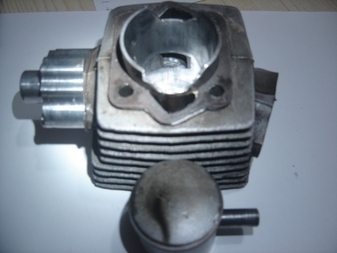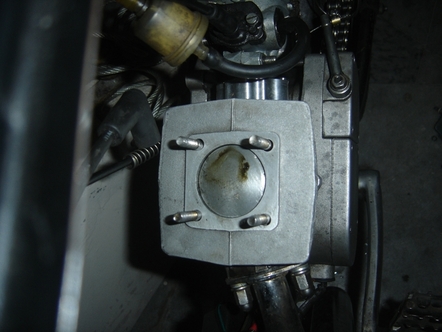Here is an extreme
example of intake charge being sucked out the
exhaust. In this picture you can see that I filled in a good portion of
the transfer ports on the intake side with JBWeld so that the intake
charge would be directed to the center of the cylinder instead of the
rear of it. The piston is pictured with the exhaust side at the bottom
of the picture. The pattern on it shows that the right side intake
charge was being partially sucked out the exhaust port by the suction
wave because the pattern runs from the side center (where the transfer
is) to the front of the piston where the exhaust port is. The pattern
is by the transfer port that opened soonest. Looking at the pattern on
the piston lets you know if there is an imbalance. Also the black color
indicates that the jetting was too rich. Once I reduced the main jet size, removed the extra JBWeld from the transfer ports, and made sure they were opening equally on both sides then this is the pattern on the piston that showed up which is almost perfect. Notice how the residue on the piston is all at the rear of the piston now which means the flow is rearward which is perfect.  I don't think all pistons have transfer flow residues on them to tell you what is happening. It may depend on the type oil used. Mine is Super M Synthetic by Maxima. Of course, if you don't clean the piston then any flow residue left on it will just blend in to all the dark stuff coating the top. Clean the piston top before trying to check this. I only made two top speed runs to get the pattern on the piston. Total distance covered was maybe only 2 miles. How to match the transfers: Take the cylinder and piston off. Insert the piston into the cylinder so that the transfers are less than .5mm open. Shine a light up into the transfer passage and visually compare the openings of the two sides. Raise the transfer port (with your rotary tool) that is the least open so that it matches the other side. |
Home